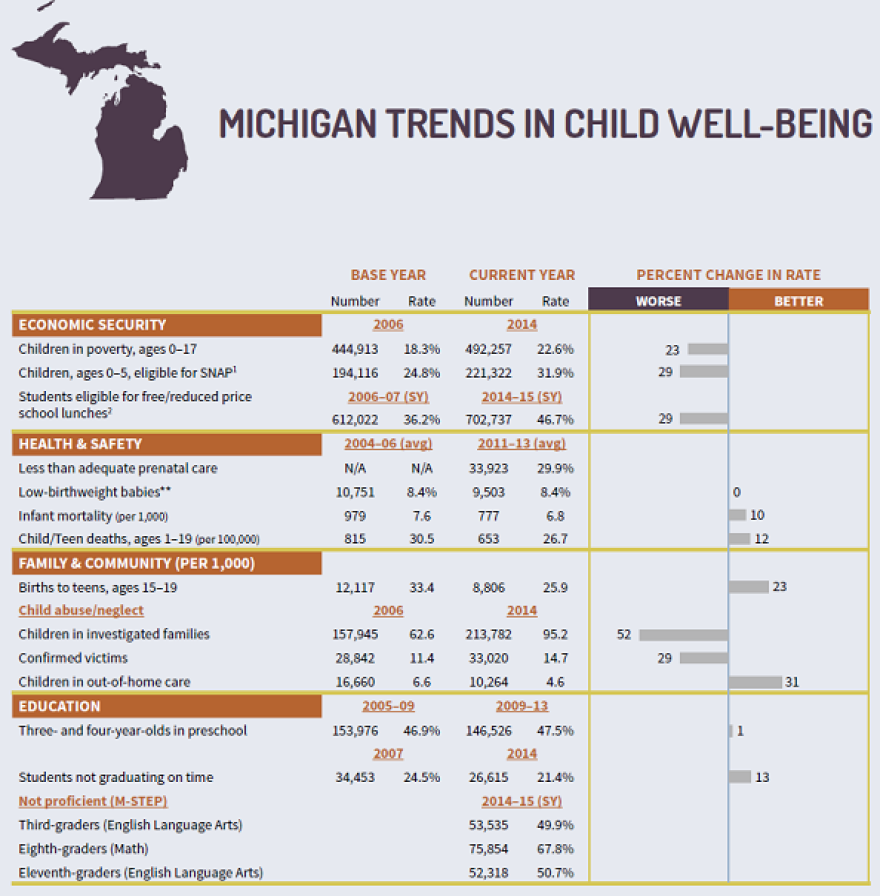The Michigan League for Public Policy released its annual Kids Count in Michigan Data Book, which takes a comprehensive look at 16 indicators of child well-being to see how kids in Michigan are doing.
And according to this year's report, which compiles data mostly from 2006 to 2014, Michigan's kids aren't doing so great.
While we've seen improvements in areas like health and education since 2006, statistics for indicators of economic security, and child abuse and neglect are startling.
Here at State of Opportunity, we've spent years investigating the barriers low-income kids face trying to get ahead in Michigan.
Research shows that poverty has a detrimental impact on a kid's health – from lead exposure and asthma, to low birth weight and infant mortality, education performance and graduate rates, and future employment and economic security.
So, why should we be alarmed by this new data? Let's take a look at some of the most troubling takeaways from the Kids Count report:
Nearly one in four children in Michigan lives in poverty (22.6 percent) – a 23% increase in the rate over 2006 and 2014. Child poverty is even higher for kids of color (47% for African-Americans and 32% for Hispanics compared to 16% for white kids) The rate of children living in families investigated for child abuse and neglect increased by 52%, and the rate of confirmed victims rose by 29% 32% of children live in a household where no parent has secure employment Nearly 80% of young children (ages 0-5) had both parents in the workforce On average, monthly child care consumed almost 40% of 2015 minimum wage earnings 17% of children in Michigan live in high-poverty neighborhoods (only seven states have a higher rate), including 18% of American Indian, 55% of African-American and 30% of Latino children.

The report also lists key recommendations to policymakers on supporting parents and improving child well-being:
Invest in communities to create safe neighborhoods, clean air and water, quality schools and adequate police and fire services Strengthen policies that support work, such as the Earned Income Tax Credit, earned paid sick leave, and workforce development opportunities Promote comprehensive strategies to prevent child abuse and neglect, including providing mental health and substance abuse services for parents Ensure access to affordable, quality child care Adequately fund public schools, targeting resources in high-need areas and providing early interventions and services.
Alicia Guevara Warren is project director at the Michigan League for Public Policy. She said in a press release:
We think all kids count – no matter where they live, their racial or ethnic background, or their family income – but do the elected officials charged with supporting their well-being share that priority? This book is not meant to be simply a reporting tool, but a catalyst for action. If legislators are truly concerned with child well-being, they have to address income and racial disparities, and invest in proven two-generation strategies that help kids by helping their parents.
Keep an eye out as we dig deeper into this year's report. I'm sure we will have lots to follow up on.
You can read the full 2016 Kids Count in Michigan Data Book here.
And check here for additional information including state, county and regional rankings, charts and images, resources for advocates, and county-specific press releases.





